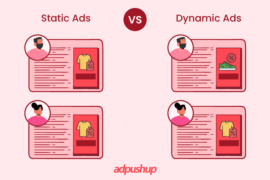Ad discrepancy is an industry wide problem. However, with some preventions this issue can be minimized. Here are the causes and how to fix ad discrepancy.
What Is Ad Discrepancy?
Ad discrepancy, or conflicts between publishers and advertisers because of data mismatch, is more complex than you think. Measurement of impressions is not as easy as putting a mathematical formula and getting the results. Rather, it depends on a lot of factors (website load time, user interaction, use of ad-block) that make impression measurement tricky.
In this post, we’ll understand what ad discrepancy is and how you can reduce it.
What is Ad Discrepancy?
Ad discrepancy is the difference in analytical data between two parties. Discrepancies occur due to the implementation of various tools, formulas, and techniques to calculate analytics data. The most common metrics publishers and advertisers refer are page views, number of impressions, and user sessions, bounce rate, and others depending on the use case.
- Currently, the ad industry is facing two different types of discrepancies; first between ad tech vendors
- And second between sell-side and buy-side platforms
Furthermore, sometimes these two types of discrepancies can even mix together and create more complexity.
Generally, ad discrepancy occurs because publishers and advertisers use different standards to calculate ad impressions and ad delivery data. For instance, publishers may calculate impressions based on the number of ad requests generated. Whereas, advertisers may calculate it based on the number of ads delivered.
Image Source: The Online Advertising Guide
Common Causes of Ad Discrepancy
- Use of different platforms:
When two or more parties are involved in analytics reporting, the chances of ad discrepancy increases. Since SSPs and ad networks work to provide the best value to publishers, they calculate ad impressions differently than DSPs, who are determined to provide the best value to advertisers.
- Latency:
Page load time plays an important role in calculating the impression number. For instance, many users leave the page while it’s loading, whereas some leave the page before ads load on the page. In both cases, the user doesn’t provide any impressions to ads which makes the calculation of impressions difficult.
- Ad blocker:
Ad blocker software blocks both URL and codes in order to stop ads from displaying on the web page. Hence, the methods used to block ads cause serious discrepancy issues. For instance, if an ad blocker stops all the Ad class, then any ad placed in Ad class will not appear on the user’s browser. But to the publisher, the user is still active and is accessing the ad unit. While at the same time, the advertiser didn’t get to display any ad, so it won’t be an impression to him.
- Third-party vendor:
Often publishers and advertisers partner with a third-party vendor/platform (like Google Analytics) to calculate the behavior of their users. When both publishers and advertisers use the same vendor/platform, the chances of impression discrepancy reduce. However, in case of different third-party vendors/platforms, things get tricky and hence the impression numbers may vary considerably.
- Not using cache buster:
Every time a user opens a webpage, the browser cache saves the details of the webpage into the system. The details are then used whenever the user loads the same web page again. This same thing happens not just for content, but also for ad units. This can mess the analytics report, for sure. Hence, integrating cache buster to website can save publishers from such a mess. Cache buster technology is used to make sure every time a user loads or reloads the webpage, each ad renders from ad server, not the web browser.
- Difference in time zone and geography:
Many analytics reports provide data in 24 hr gap rather than providing real-time reports. For instance, if a publisher uses EST timezone and reports are generated at 12 am every day, whereas advertiser uses PMT timezone then there is a gap of 2 hours. There will always be a 2-hour difference in reports generated by both causing discrepancies.
How Ad Discrepancy Affects Publishers?
If the difference between the data of two parties is under 5%, usually there is nothing to worry about. However, if the percentage comes as considerable as 20% or more, then started looking for methods to decrease discrepancy (some of which are mentioned above).
Ad discrepancy affects publishers and advertisers, equally. Now you may think that advertisers pay money to show ads and their money is at stake. However, at the same time, ad impression conflict is capable of ruining the reputation and market value of publishers. If the impression numbers provided by publishers are not accurate, an advertiser would think the publisher is overselling the inventories.
For example, your (publisher’s) analytics report shows an average of a hundred thousand impressions per month, but 30% users leave the webpage without it’s completely loaded. Meaning, 30% users are accessing the webpage but not providing any impressions to ads. But you are also showing those hundred thousand impressions per month. In this case, advertisers think the numbers are exaggerated and may find dealing with you incredible.
Keeping this in mind, publishers are advised to deal with vendors who have Media Rating Council (MRC) accreditation. MRC examines the vendors and their services to provide audience measurement services. However, dealing with MRC accredited vendors doesn’t mean you will get 100% accurate results, but the data will be approximately accurate as required by the ad tech industry.
Tips to Mitigate Ad Discrepancy
It’s wise to start the investigation from your side and then move outward in the system to eliminate ad discrepancy.
A publisher can start by checking whether cache buster software is active or not. It is a simple piece of code needed to be placed in your website source code. Also, if you use WordPress, you can find a cache buster plugin and use it.
Furthermore, if you are dealing with vendors, advertisers, and agencies located in different geographical locations or time zones, try to come up with a standard time-zone to calculate impressions.
Finally, run tests and create an elaborate impression discrepancy report. This report can help you pinpoint the causes for ad discrepancy, including the day, for a particular ad unit (or size), timezone and geographical location causing the problem. It’s important for publishers to understand where impressions are being lost and consecutively find workarounds to resolve them.
FAQs
A metric discrepancy occurs when the sell-side and the buy-side calculate metrics differently at the end of the reporting period. The discrepancy can be traced to a variety of metrics, including time spent on the page and conversions, but clicks and impressions are most commonly affected.
Discrepancies occur when different tools, formulas, and techniques are used to calculate analytics data. Depending on the use case, publishers and advertisers refer to page views, impressions, user sessions, bounce rate, and others.
Discrepancies of different types:-
A discrepancy caused by the system, also known as a data discrepancy. A discrepancy that is generated by a user, also known as a manual discrepancy.

Shubham is a digital marketer with rich experience working in the advertisement technology industry. He has vast experience in the programmatic industry, driving business strategy and scaling functions including but not limited to growth and marketing, Operations, process optimization, and Sales.







